CNA157 Module: Responding to Diversity - Global Perspective Essay
VerifiedAdded on 2022/09/18
|8
|1894
|21
Essay
AI Summary
This essay, written from a Nepalese-Australian nursing student's perspective, explores the multifaceted nature of responding to diversity in healthcare. It begins by defining intersectionality and its significance in a diverse environment, drawing on personal experiences and the cultural context of Nepal. The essay delves into how cultural factors, including location, institutional culture, and values, shape individuals' behaviors and interactions, emphasizing the importance of accepting diversity and addressing potential biases in healthcare practices. It highlights the impact of unconscious biases on patient care and proposes culturally safe healthcare practices, such as developing awareness and improving communication. The essay further examines a multi-dimensional approach to reduce racial health care disparities, including physician-focused and system-focused strategies, and underscores the significance of cultural competence in providing equitable care. It concludes by advocating for the implementation of a Cultural Competency Model to eliminate biased treatment in the healthcare sector. The essay references several studies to support its arguments.
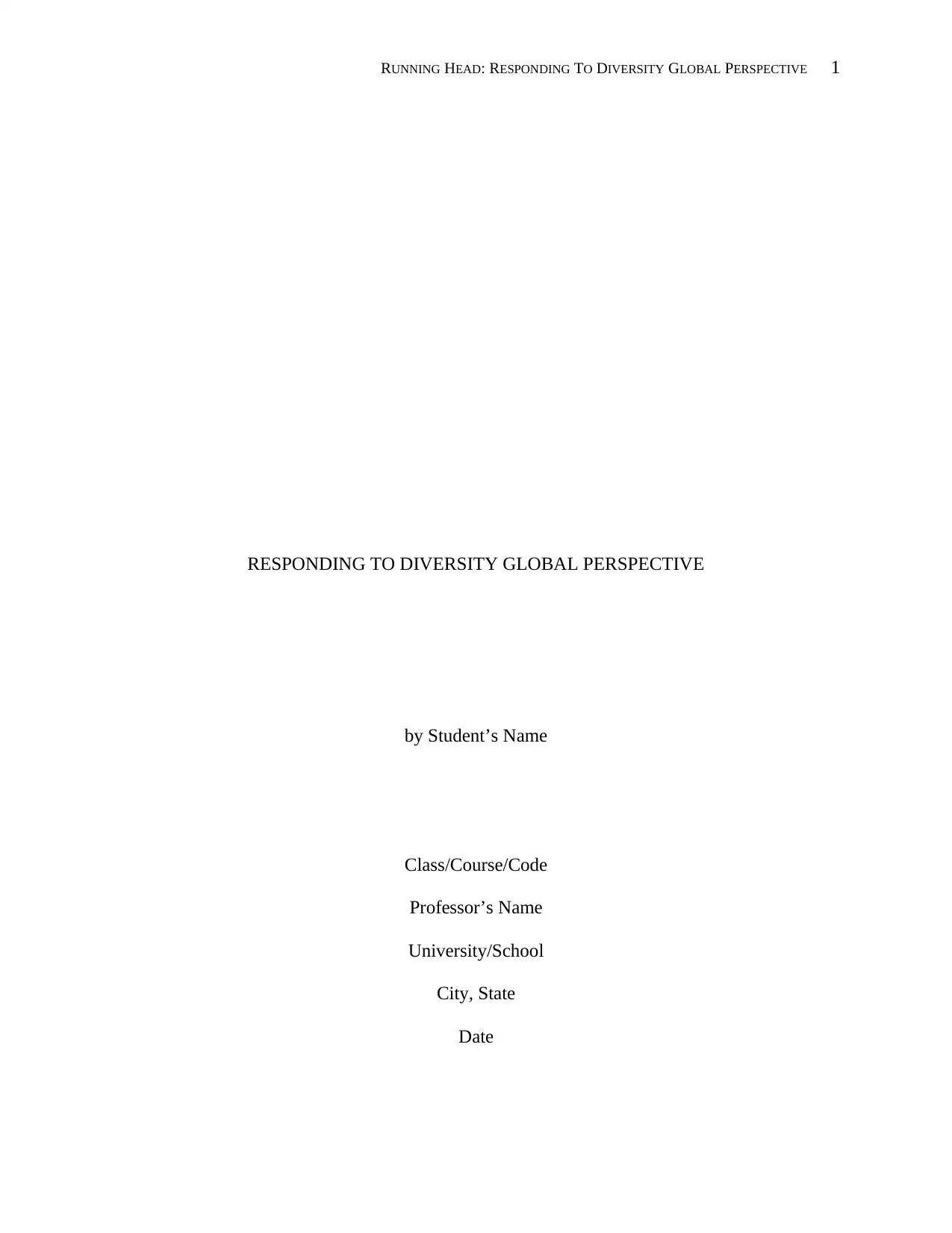
RUNNING HEAD: RESPONDING TO DIVERSITY GLOBAL PERSPECTIVE 1
RESPONDING TO DIVERSITY GLOBAL PERSPECTIVE
by Student’s Name
Class/Course/Code
Professor’s Name
University/School
City, State
Date
RESPONDING TO DIVERSITY GLOBAL PERSPECTIVE
by Student’s Name
Class/Course/Code
Professor’s Name
University/School
City, State
Date
Paraphrase This Document
Need a fresh take? Get an instant paraphrase of this document with our AI Paraphraser
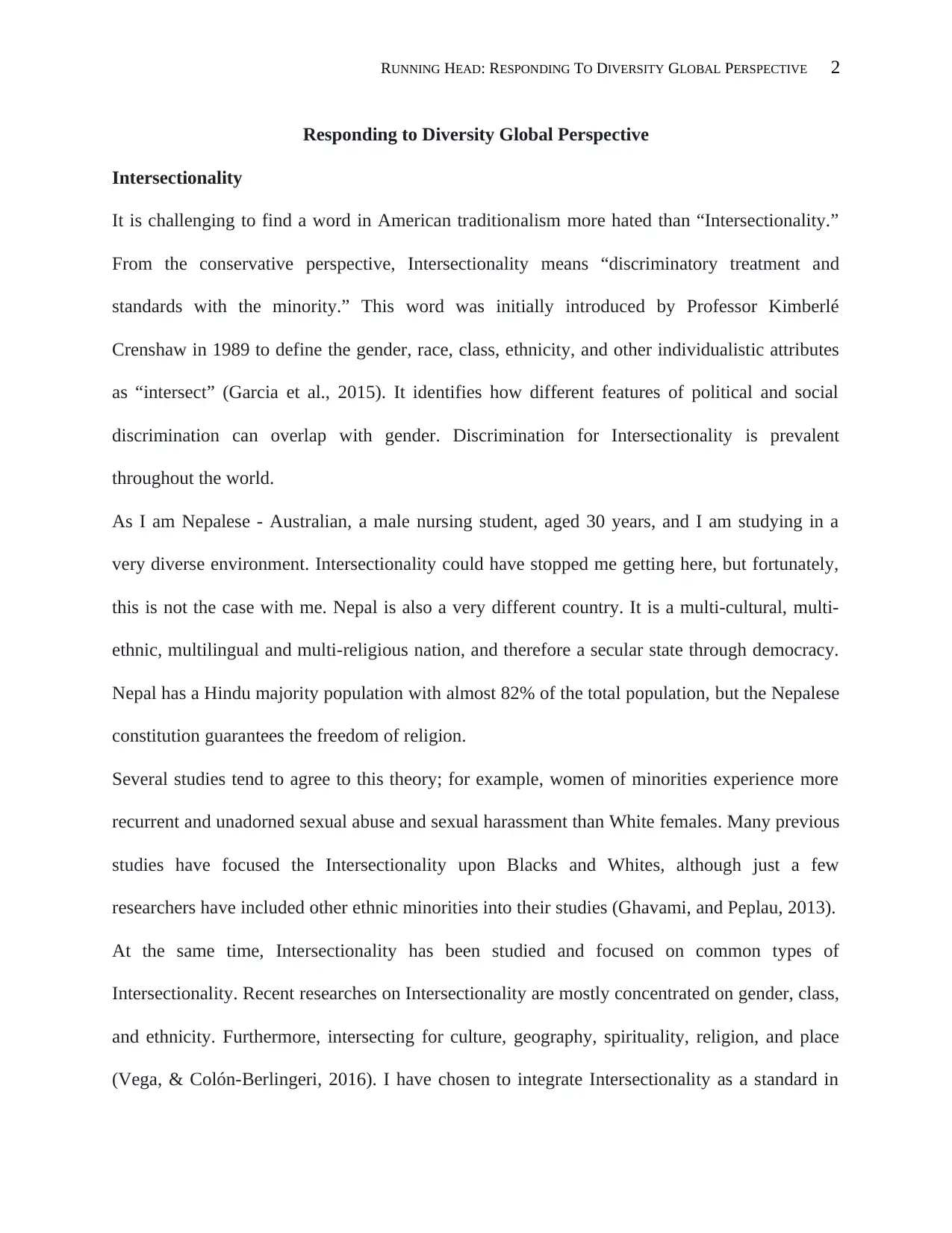
RUNNING HEAD: RESPONDING TO DIVERSITY GLOBAL PERSPECTIVE 2
Responding to Diversity Global Perspective
Intersectionality
It is challenging to find a word in American traditionalism more hated than “Intersectionality.”
From the conservative perspective, Intersectionality means “discriminatory treatment and
standards with the minority.” This word was initially introduced by Professor Kimberlé
Crenshaw in 1989 to define the gender, race, class, ethnicity, and other individualistic attributes
as “intersect” (Garcia et al., 2015). It identifies how different features of political and social
discrimination can overlap with gender. Discrimination for Intersectionality is prevalent
throughout the world.
As I am Nepalese - Australian, a male nursing student, aged 30 years, and I am studying in a
very diverse environment. Intersectionality could have stopped me getting here, but fortunately,
this is not the case with me. Nepal is also a very different country. It is a multi-cultural, multi-
ethnic, multilingual and multi-religious nation, and therefore a secular state through democracy.
Nepal has a Hindu majority population with almost 82% of the total population, but the Nepalese
constitution guarantees the freedom of religion.
Several studies tend to agree to this theory; for example, women of minorities experience more
recurrent and unadorned sexual abuse and sexual harassment than White females. Many previous
studies have focused the Intersectionality upon Blacks and Whites, although just a few
researchers have included other ethnic minorities into their studies (Ghavami, and Peplau, 2013).
At the same time, Intersectionality has been studied and focused on common types of
Intersectionality. Recent researches on Intersectionality are mostly concentrated on gender, class,
and ethnicity. Furthermore, intersecting for culture, geography, spirituality, religion, and place
(Vega, & Colón-Berlingeri, 2016). I have chosen to integrate Intersectionality as a standard in
Responding to Diversity Global Perspective
Intersectionality
It is challenging to find a word in American traditionalism more hated than “Intersectionality.”
From the conservative perspective, Intersectionality means “discriminatory treatment and
standards with the minority.” This word was initially introduced by Professor Kimberlé
Crenshaw in 1989 to define the gender, race, class, ethnicity, and other individualistic attributes
as “intersect” (Garcia et al., 2015). It identifies how different features of political and social
discrimination can overlap with gender. Discrimination for Intersectionality is prevalent
throughout the world.
As I am Nepalese - Australian, a male nursing student, aged 30 years, and I am studying in a
very diverse environment. Intersectionality could have stopped me getting here, but fortunately,
this is not the case with me. Nepal is also a very different country. It is a multi-cultural, multi-
ethnic, multilingual and multi-religious nation, and therefore a secular state through democracy.
Nepal has a Hindu majority population with almost 82% of the total population, but the Nepalese
constitution guarantees the freedom of religion.
Several studies tend to agree to this theory; for example, women of minorities experience more
recurrent and unadorned sexual abuse and sexual harassment than White females. Many previous
studies have focused the Intersectionality upon Blacks and Whites, although just a few
researchers have included other ethnic minorities into their studies (Ghavami, and Peplau, 2013).
At the same time, Intersectionality has been studied and focused on common types of
Intersectionality. Recent researches on Intersectionality are mostly concentrated on gender, class,
and ethnicity. Furthermore, intersecting for culture, geography, spirituality, religion, and place
(Vega, & Colón-Berlingeri, 2016). I have chosen to integrate Intersectionality as a standard in
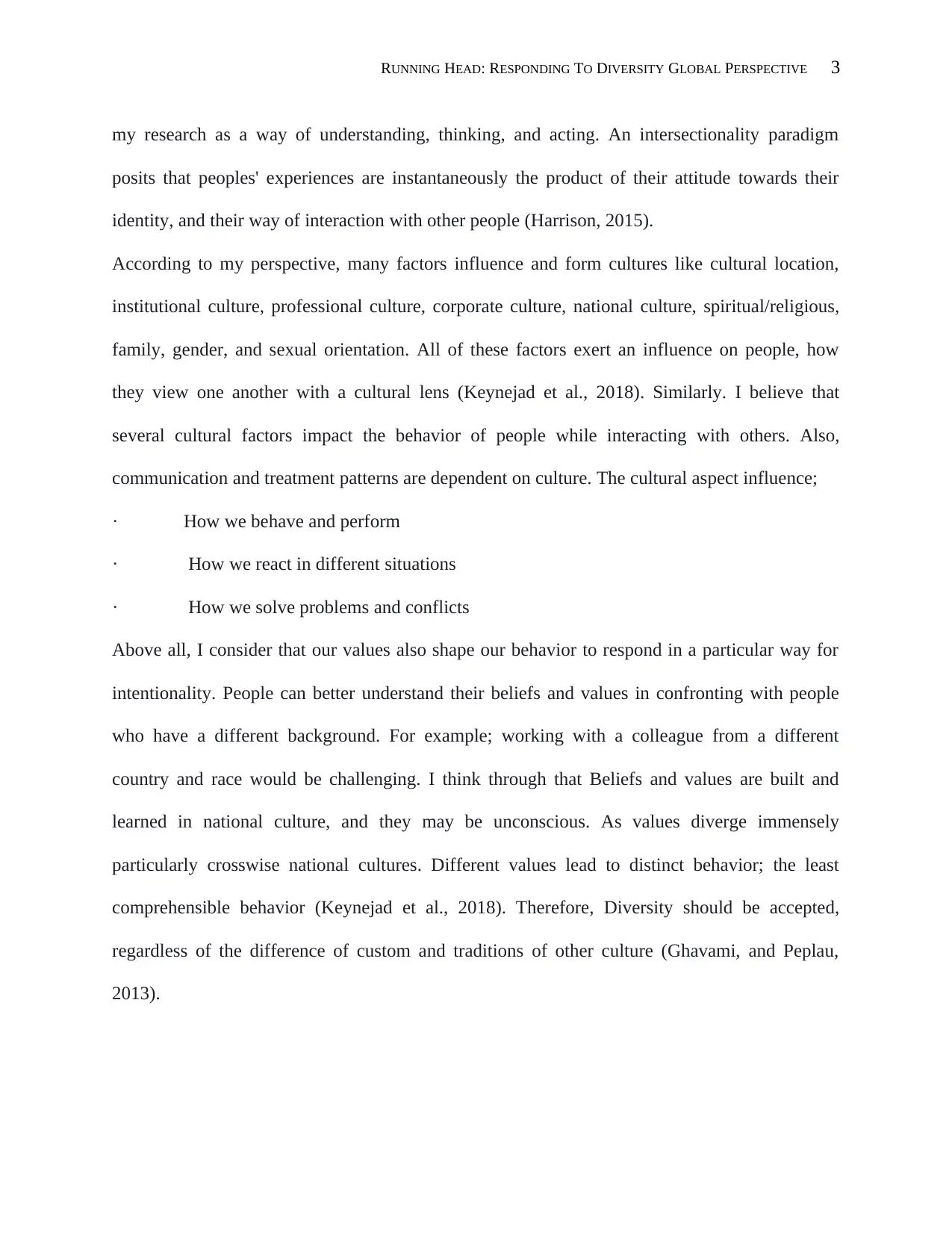
RUNNING HEAD: RESPONDING TO DIVERSITY GLOBAL PERSPECTIVE 3
my research as a way of understanding, thinking, and acting. An intersectionality paradigm
posits that peoples' experiences are instantaneously the product of their attitude towards their
identity, and their way of interaction with other people (Harrison, 2015).
According to my perspective, many factors influence and form cultures like cultural location,
institutional culture, professional culture, corporate culture, national culture, spiritual/religious,
family, gender, and sexual orientation. All of these factors exert an influence on people, how
they view one another with a cultural lens (Keynejad et al., 2018). Similarly. I believe that
several cultural factors impact the behavior of people while interacting with others. Also,
communication and treatment patterns are dependent on culture. The cultural aspect influence;
· How we behave and perform
· How we react in different situations
· How we solve problems and conflicts
Above all, I consider that our values also shape our behavior to respond in a particular way for
intentionality. People can better understand their beliefs and values in confronting with people
who have a different background. For example; working with a colleague from a different
country and race would be challenging. I think through that Beliefs and values are built and
learned in national culture, and they may be unconscious. As values diverge immensely
particularly crosswise national cultures. Different values lead to distinct behavior; the least
comprehensible behavior (Keynejad et al., 2018). Therefore, Diversity should be accepted,
regardless of the difference of custom and traditions of other culture (Ghavami, and Peplau,
2013).
my research as a way of understanding, thinking, and acting. An intersectionality paradigm
posits that peoples' experiences are instantaneously the product of their attitude towards their
identity, and their way of interaction with other people (Harrison, 2015).
According to my perspective, many factors influence and form cultures like cultural location,
institutional culture, professional culture, corporate culture, national culture, spiritual/religious,
family, gender, and sexual orientation. All of these factors exert an influence on people, how
they view one another with a cultural lens (Keynejad et al., 2018). Similarly. I believe that
several cultural factors impact the behavior of people while interacting with others. Also,
communication and treatment patterns are dependent on culture. The cultural aspect influence;
· How we behave and perform
· How we react in different situations
· How we solve problems and conflicts
Above all, I consider that our values also shape our behavior to respond in a particular way for
intentionality. People can better understand their beliefs and values in confronting with people
who have a different background. For example; working with a colleague from a different
country and race would be challenging. I think through that Beliefs and values are built and
learned in national culture, and they may be unconscious. As values diverge immensely
particularly crosswise national cultures. Different values lead to distinct behavior; the least
comprehensible behavior (Keynejad et al., 2018). Therefore, Diversity should be accepted,
regardless of the difference of custom and traditions of other culture (Ghavami, and Peplau,
2013).
⊘ This is a preview!⊘
Do you want full access?
Subscribe today to unlock all pages.

Trusted by 1+ million students worldwide
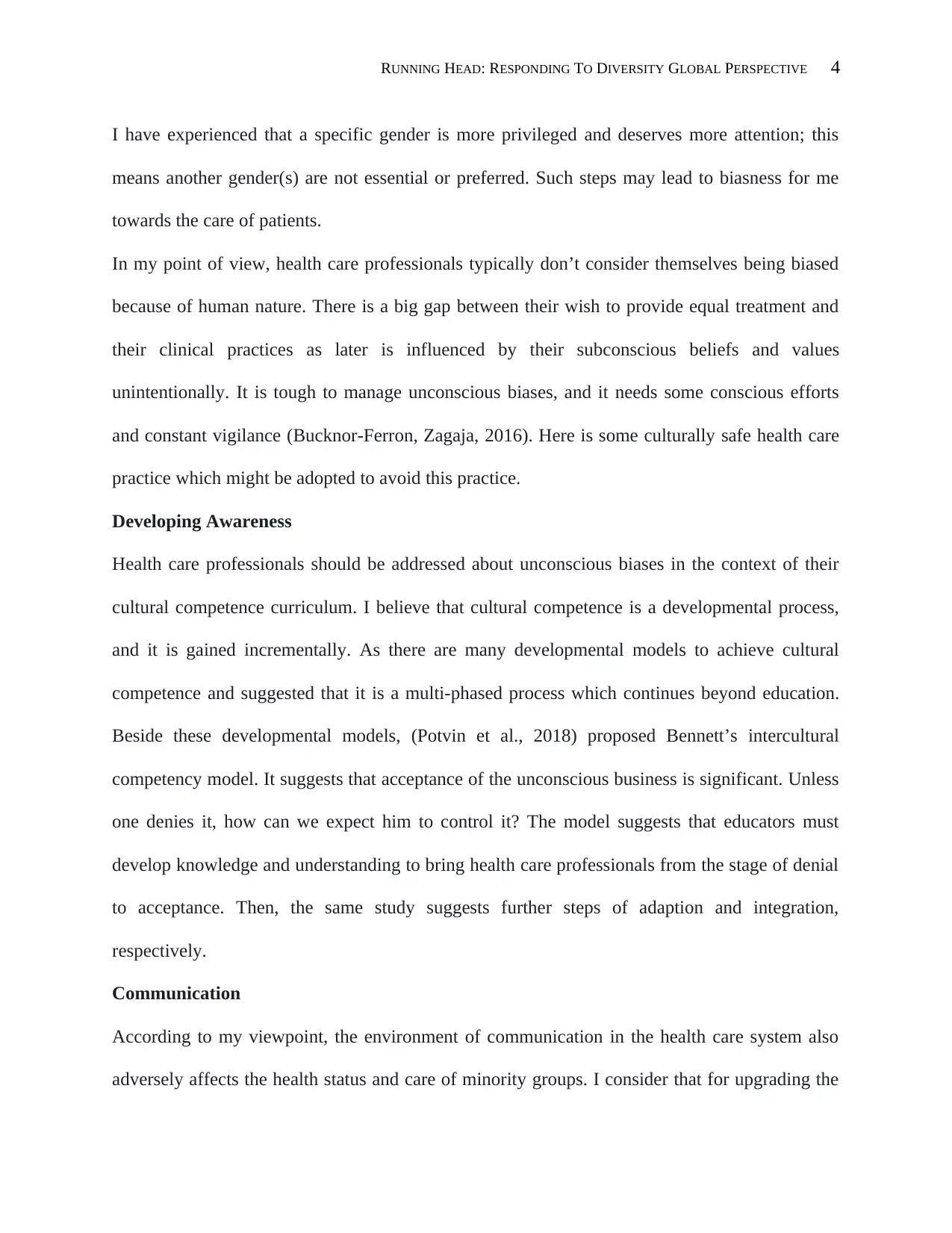
RUNNING HEAD: RESPONDING TO DIVERSITY GLOBAL PERSPECTIVE 4
I have experienced that a specific gender is more privileged and deserves more attention; this
means another gender(s) are not essential or preferred. Such steps may lead to biasness for me
towards the care of patients.
In my point of view, health care professionals typically don’t consider themselves being biased
because of human nature. There is a big gap between their wish to provide equal treatment and
their clinical practices as later is influenced by their subconscious beliefs and values
unintentionally. It is tough to manage unconscious biases, and it needs some conscious efforts
and constant vigilance (Bucknor-Ferron, Zagaja, 2016). Here is some culturally safe health care
practice which might be adopted to avoid this practice.
Developing Awareness
Health care professionals should be addressed about unconscious biases in the context of their
cultural competence curriculum. I believe that cultural competence is a developmental process,
and it is gained incrementally. As there are many developmental models to achieve cultural
competence and suggested that it is a multi-phased process which continues beyond education.
Beside these developmental models, (Potvin et al., 2018) proposed Bennett’s intercultural
competency model. It suggests that acceptance of the unconscious business is significant. Unless
one denies it, how can we expect him to control it? The model suggests that educators must
develop knowledge and understanding to bring health care professionals from the stage of denial
to acceptance. Then, the same study suggests further steps of adaption and integration,
respectively.
Communication
According to my viewpoint, the environment of communication in the health care system also
adversely affects the health status and care of minority groups. I consider that for upgrading the
I have experienced that a specific gender is more privileged and deserves more attention; this
means another gender(s) are not essential or preferred. Such steps may lead to biasness for me
towards the care of patients.
In my point of view, health care professionals typically don’t consider themselves being biased
because of human nature. There is a big gap between their wish to provide equal treatment and
their clinical practices as later is influenced by their subconscious beliefs and values
unintentionally. It is tough to manage unconscious biases, and it needs some conscious efforts
and constant vigilance (Bucknor-Ferron, Zagaja, 2016). Here is some culturally safe health care
practice which might be adopted to avoid this practice.
Developing Awareness
Health care professionals should be addressed about unconscious biases in the context of their
cultural competence curriculum. I believe that cultural competence is a developmental process,
and it is gained incrementally. As there are many developmental models to achieve cultural
competence and suggested that it is a multi-phased process which continues beyond education.
Beside these developmental models, (Potvin et al., 2018) proposed Bennett’s intercultural
competency model. It suggests that acceptance of the unconscious business is significant. Unless
one denies it, how can we expect him to control it? The model suggests that educators must
develop knowledge and understanding to bring health care professionals from the stage of denial
to acceptance. Then, the same study suggests further steps of adaption and integration,
respectively.
Communication
According to my viewpoint, the environment of communication in the health care system also
adversely affects the health status and care of minority groups. I consider that for upgrading the
Paraphrase This Document
Need a fresh take? Get an instant paraphrase of this document with our AI Paraphraser
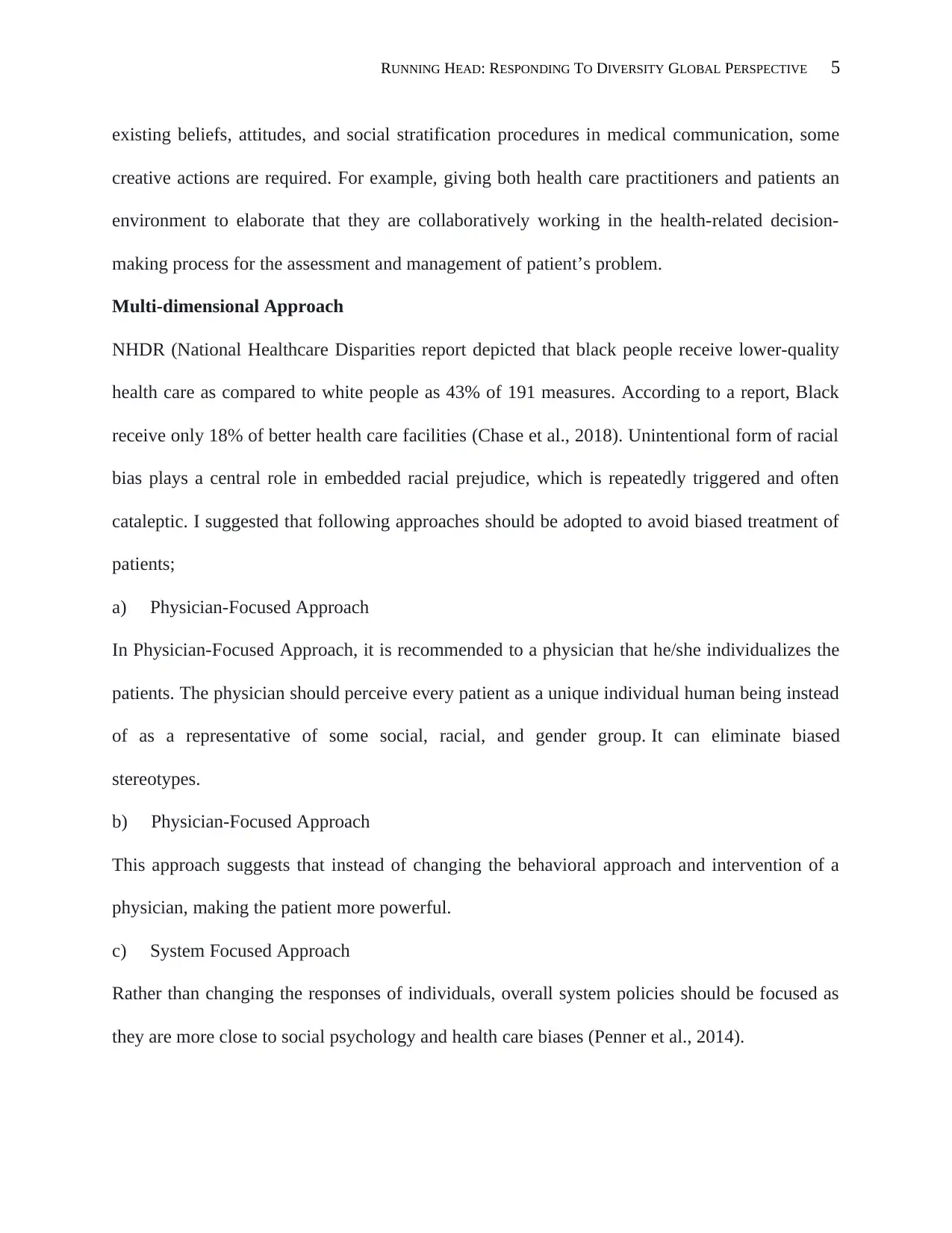
RUNNING HEAD: RESPONDING TO DIVERSITY GLOBAL PERSPECTIVE 5
existing beliefs, attitudes, and social stratification procedures in medical communication, some
creative actions are required. For example, giving both health care practitioners and patients an
environment to elaborate that they are collaboratively working in the health-related decision-
making process for the assessment and management of patient’s problem.
Multi-dimensional Approach
NHDR (National Healthcare Disparities report depicted that black people receive lower-quality
health care as compared to white people as 43% of 191 measures. According to a report, Black
receive only 18% of better health care facilities (Chase et al., 2018). Unintentional form of racial
bias plays a central role in embedded racial prejudice, which is repeatedly triggered and often
cataleptic. I suggested that following approaches should be adopted to avoid biased treatment of
patients;
a) Physician-Focused Approach
In Physician-Focused Approach, it is recommended to a physician that he/she individualizes the
patients. The physician should perceive every patient as a unique individual human being instead
of as a representative of some social, racial, and gender group. It can eliminate biased
stereotypes.
b) Physician-Focused Approach
This approach suggests that instead of changing the behavioral approach and intervention of a
physician, making the patient more powerful.
c) System Focused Approach
Rather than changing the responses of individuals, overall system policies should be focused as
they are more close to social psychology and health care biases (Penner et al., 2014).
existing beliefs, attitudes, and social stratification procedures in medical communication, some
creative actions are required. For example, giving both health care practitioners and patients an
environment to elaborate that they are collaboratively working in the health-related decision-
making process for the assessment and management of patient’s problem.
Multi-dimensional Approach
NHDR (National Healthcare Disparities report depicted that black people receive lower-quality
health care as compared to white people as 43% of 191 measures. According to a report, Black
receive only 18% of better health care facilities (Chase et al., 2018). Unintentional form of racial
bias plays a central role in embedded racial prejudice, which is repeatedly triggered and often
cataleptic. I suggested that following approaches should be adopted to avoid biased treatment of
patients;
a) Physician-Focused Approach
In Physician-Focused Approach, it is recommended to a physician that he/she individualizes the
patients. The physician should perceive every patient as a unique individual human being instead
of as a representative of some social, racial, and gender group. It can eliminate biased
stereotypes.
b) Physician-Focused Approach
This approach suggests that instead of changing the behavioral approach and intervention of a
physician, making the patient more powerful.
c) System Focused Approach
Rather than changing the responses of individuals, overall system policies should be focused as
they are more close to social psychology and health care biases (Penner et al., 2014).
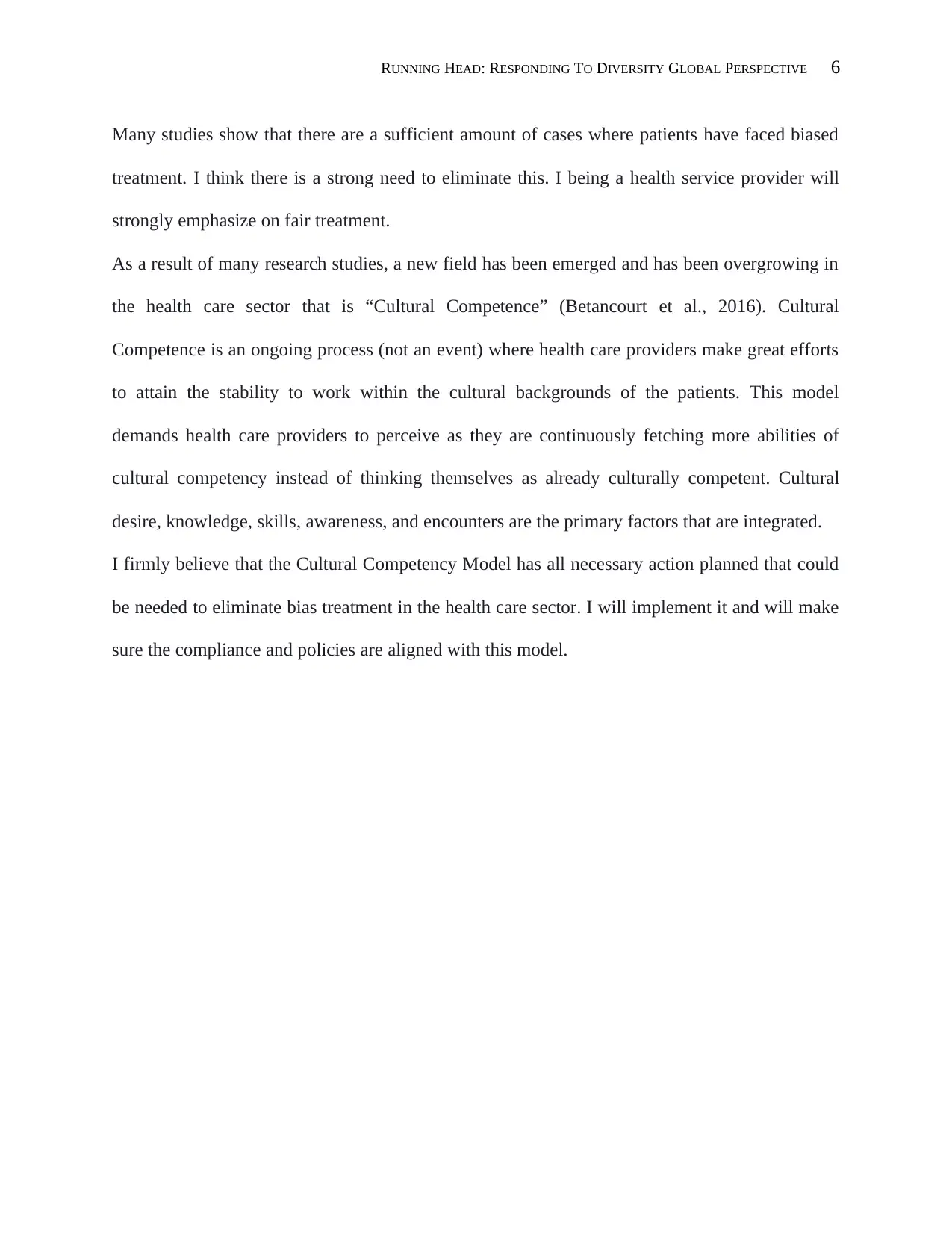
RUNNING HEAD: RESPONDING TO DIVERSITY GLOBAL PERSPECTIVE 6
Many studies show that there are a sufficient amount of cases where patients have faced biased
treatment. I think there is a strong need to eliminate this. I being a health service provider will
strongly emphasize on fair treatment.
As a result of many research studies, a new field has been emerged and has been overgrowing in
the health care sector that is “Cultural Competence” (Betancourt et al., 2016). Cultural
Competence is an ongoing process (not an event) where health care providers make great efforts
to attain the stability to work within the cultural backgrounds of the patients. This model
demands health care providers to perceive as they are continuously fetching more abilities of
cultural competency instead of thinking themselves as already culturally competent. Cultural
desire, knowledge, skills, awareness, and encounters are the primary factors that are integrated.
I firmly believe that the Cultural Competency Model has all necessary action planned that could
be needed to eliminate bias treatment in the health care sector. I will implement it and will make
sure the compliance and policies are aligned with this model.
Many studies show that there are a sufficient amount of cases where patients have faced biased
treatment. I think there is a strong need to eliminate this. I being a health service provider will
strongly emphasize on fair treatment.
As a result of many research studies, a new field has been emerged and has been overgrowing in
the health care sector that is “Cultural Competence” (Betancourt et al., 2016). Cultural
Competence is an ongoing process (not an event) where health care providers make great efforts
to attain the stability to work within the cultural backgrounds of the patients. This model
demands health care providers to perceive as they are continuously fetching more abilities of
cultural competency instead of thinking themselves as already culturally competent. Cultural
desire, knowledge, skills, awareness, and encounters are the primary factors that are integrated.
I firmly believe that the Cultural Competency Model has all necessary action planned that could
be needed to eliminate bias treatment in the health care sector. I will implement it and will make
sure the compliance and policies are aligned with this model.
⊘ This is a preview!⊘
Do you want full access?
Subscribe today to unlock all pages.

Trusted by 1+ million students worldwide
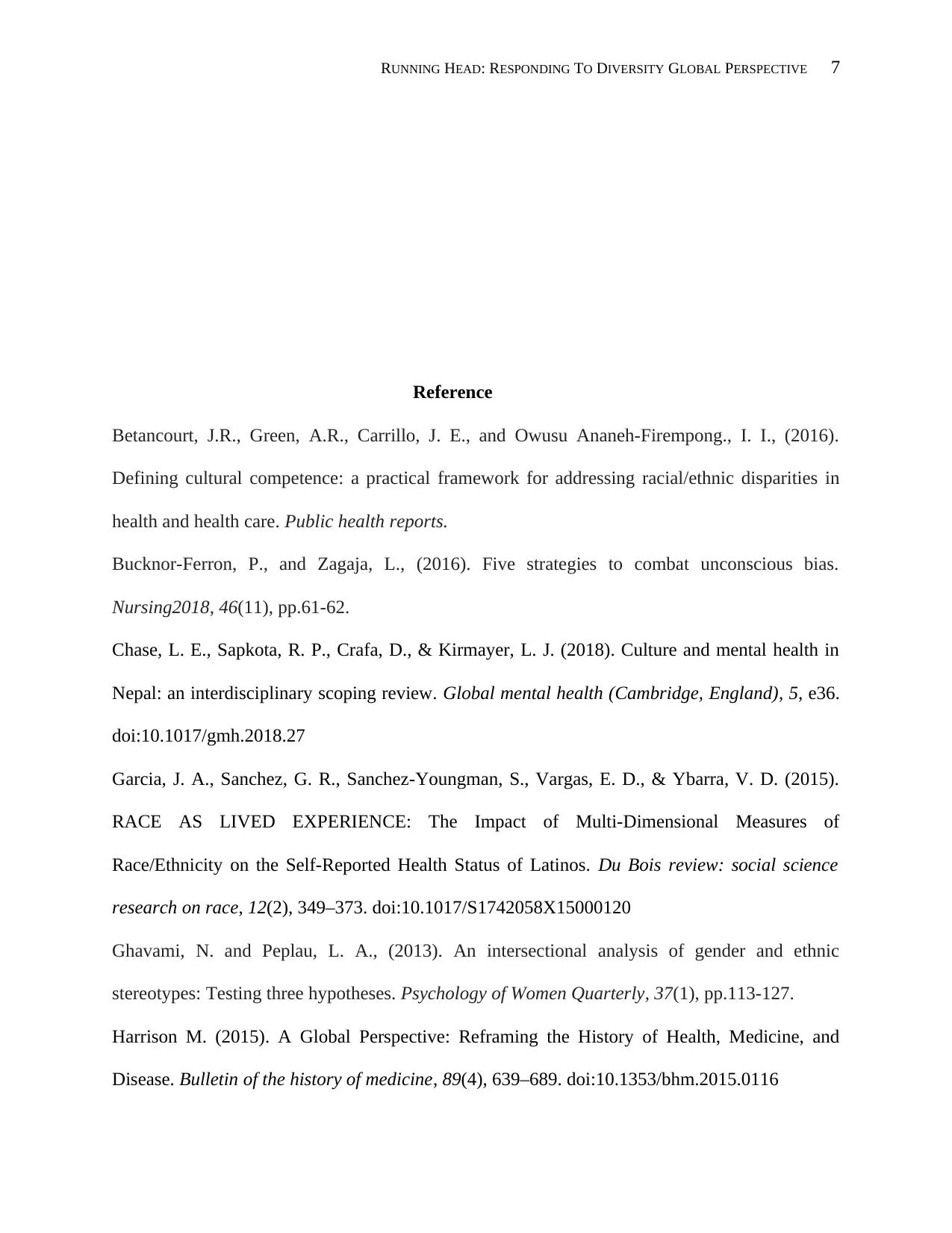
RUNNING HEAD: RESPONDING TO DIVERSITY GLOBAL PERSPECTIVE 7
Reference
Betancourt, J.R., Green, A.R., Carrillo, J. E., and Owusu Ananeh-Firempong., I. I., (2016).
Defining cultural competence: a practical framework for addressing racial/ethnic disparities in
health and health care. Public health reports.
Bucknor-Ferron, P., and Zagaja, L., (2016). Five strategies to combat unconscious bias.
Nursing2018, 46(11), pp.61-62.
Chase, L. E., Sapkota, R. P., Crafa, D., & Kirmayer, L. J. (2018). Culture and mental health in
Nepal: an interdisciplinary scoping review. Global mental health (Cambridge, England), 5, e36.
doi:10.1017/gmh.2018.27
Garcia, J. A., Sanchez, G. R., Sanchez-Youngman, S., Vargas, E. D., & Ybarra, V. D. (2015).
RACE AS LIVED EXPERIENCE: The Impact of Multi-Dimensional Measures of
Race/Ethnicity on the Self-Reported Health Status of Latinos. Du Bois review: social science
research on race, 12(2), 349–373. doi:10.1017/S1742058X15000120
Ghavami, N. and Peplau, L. A., (2013). An intersectional analysis of gender and ethnic
stereotypes: Testing three hypotheses. Psychology of Women Quarterly, 37(1), pp.113-127.
Harrison M. (2015). A Global Perspective: Reframing the History of Health, Medicine, and
Disease. Bulletin of the history of medicine, 89(4), 639–689. doi:10.1353/bhm.2015.0116
Reference
Betancourt, J.R., Green, A.R., Carrillo, J. E., and Owusu Ananeh-Firempong., I. I., (2016).
Defining cultural competence: a practical framework for addressing racial/ethnic disparities in
health and health care. Public health reports.
Bucknor-Ferron, P., and Zagaja, L., (2016). Five strategies to combat unconscious bias.
Nursing2018, 46(11), pp.61-62.
Chase, L. E., Sapkota, R. P., Crafa, D., & Kirmayer, L. J. (2018). Culture and mental health in
Nepal: an interdisciplinary scoping review. Global mental health (Cambridge, England), 5, e36.
doi:10.1017/gmh.2018.27
Garcia, J. A., Sanchez, G. R., Sanchez-Youngman, S., Vargas, E. D., & Ybarra, V. D. (2015).
RACE AS LIVED EXPERIENCE: The Impact of Multi-Dimensional Measures of
Race/Ethnicity on the Self-Reported Health Status of Latinos. Du Bois review: social science
research on race, 12(2), 349–373. doi:10.1017/S1742058X15000120
Ghavami, N. and Peplau, L. A., (2013). An intersectional analysis of gender and ethnic
stereotypes: Testing three hypotheses. Psychology of Women Quarterly, 37(1), pp.113-127.
Harrison M. (2015). A Global Perspective: Reframing the History of Health, Medicine, and
Disease. Bulletin of the history of medicine, 89(4), 639–689. doi:10.1353/bhm.2015.0116
Paraphrase This Document
Need a fresh take? Get an instant paraphrase of this document with our AI Paraphraser
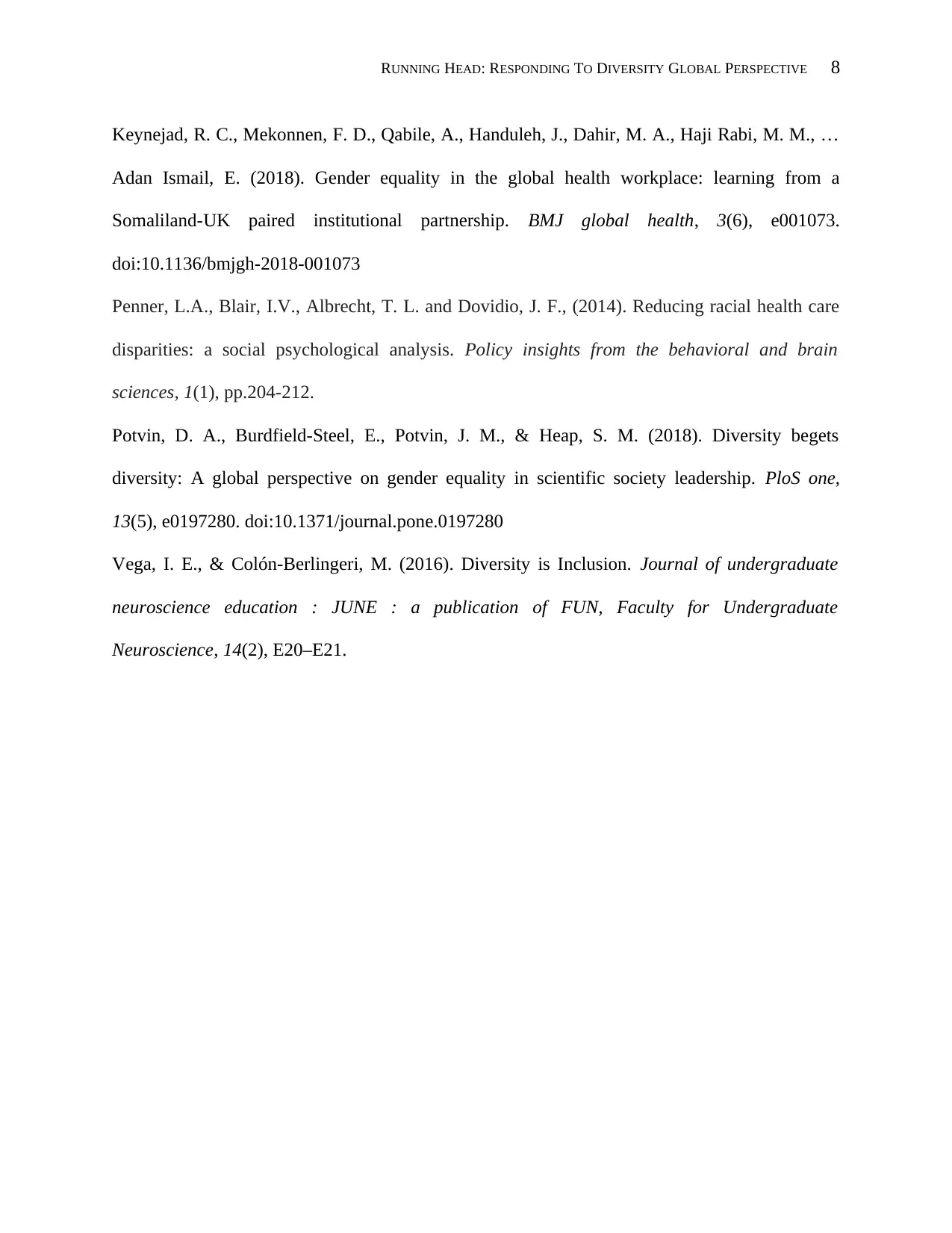
RUNNING HEAD: RESPONDING TO DIVERSITY GLOBAL PERSPECTIVE 8
Keynejad, R. C., Mekonnen, F. D., Qabile, A., Handuleh, J., Dahir, M. A., Haji Rabi, M. M., …
Adan Ismail, E. (2018). Gender equality in the global health workplace: learning from a
Somaliland-UK paired institutional partnership. BMJ global health, 3(6), e001073.
doi:10.1136/bmjgh-2018-001073
Penner, L.A., Blair, I.V., Albrecht, T. L. and Dovidio, J. F., (2014). Reducing racial health care
disparities: a social psychological analysis. Policy insights from the behavioral and brain
sciences, 1(1), pp.204-212.
Potvin, D. A., Burdfield-Steel, E., Potvin, J. M., & Heap, S. M. (2018). Diversity begets
diversity: A global perspective on gender equality in scientific society leadership. PloS one,
13(5), e0197280. doi:10.1371/journal.pone.0197280
Vega, I. E., & Colón-Berlingeri, M. (2016). Diversity is Inclusion. Journal of undergraduate
neuroscience education : JUNE : a publication of FUN, Faculty for Undergraduate
Neuroscience, 14(2), E20–E21.
Keynejad, R. C., Mekonnen, F. D., Qabile, A., Handuleh, J., Dahir, M. A., Haji Rabi, M. M., …
Adan Ismail, E. (2018). Gender equality in the global health workplace: learning from a
Somaliland-UK paired institutional partnership. BMJ global health, 3(6), e001073.
doi:10.1136/bmjgh-2018-001073
Penner, L.A., Blair, I.V., Albrecht, T. L. and Dovidio, J. F., (2014). Reducing racial health care
disparities: a social psychological analysis. Policy insights from the behavioral and brain
sciences, 1(1), pp.204-212.
Potvin, D. A., Burdfield-Steel, E., Potvin, J. M., & Heap, S. M. (2018). Diversity begets
diversity: A global perspective on gender equality in scientific society leadership. PloS one,
13(5), e0197280. doi:10.1371/journal.pone.0197280
Vega, I. E., & Colón-Berlingeri, M. (2016). Diversity is Inclusion. Journal of undergraduate
neuroscience education : JUNE : a publication of FUN, Faculty for Undergraduate
Neuroscience, 14(2), E20–E21.
1 out of 8
Related Documents
Your All-in-One AI-Powered Toolkit for Academic Success.
+13062052269
info@desklib.com
Available 24*7 on WhatsApp / Email
![[object Object]](/_next/static/media/star-bottom.7253800d.svg)
Unlock your academic potential
Copyright © 2020–2025 A2Z Services. All Rights Reserved. Developed and managed by ZUCOL.





